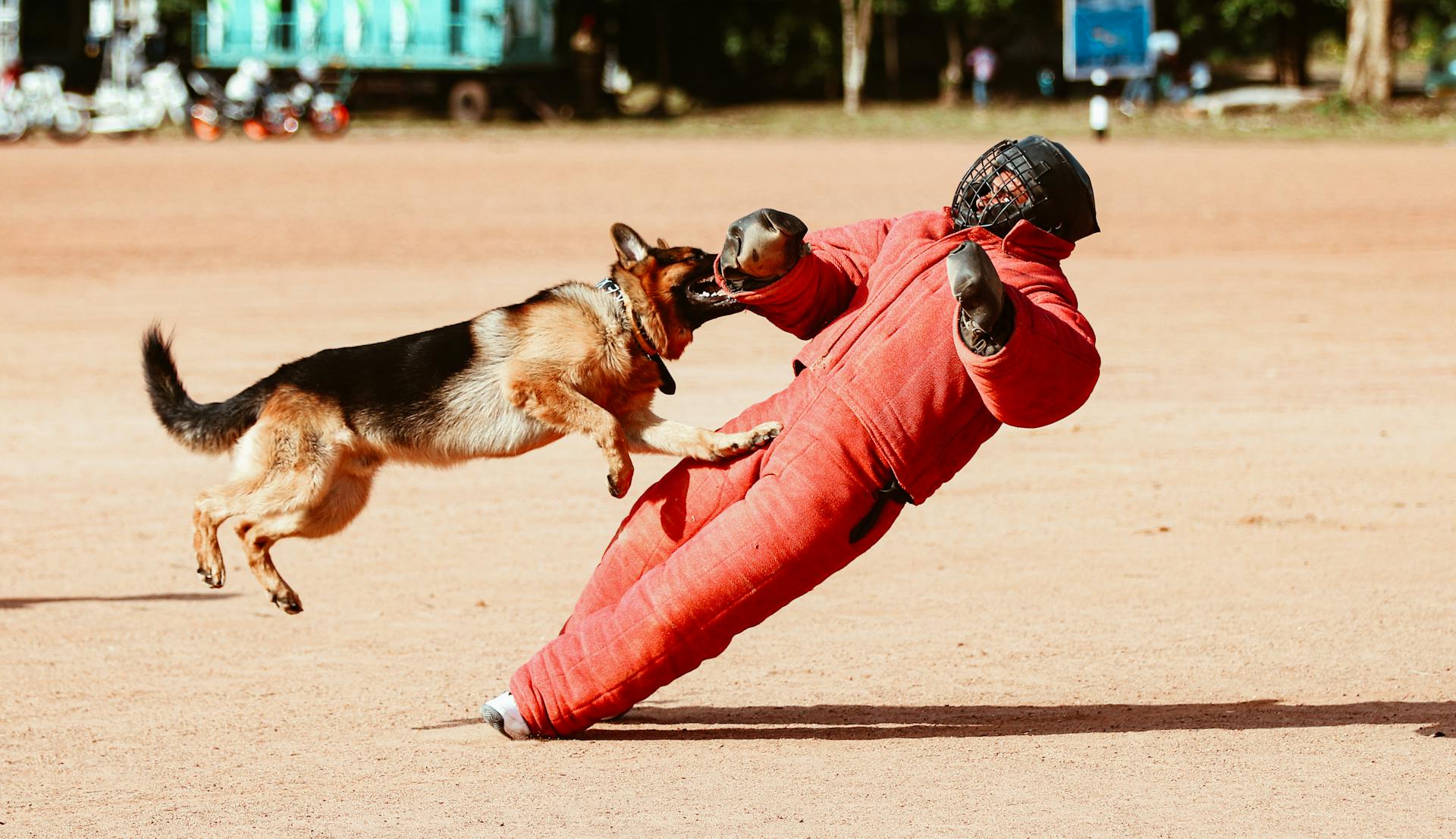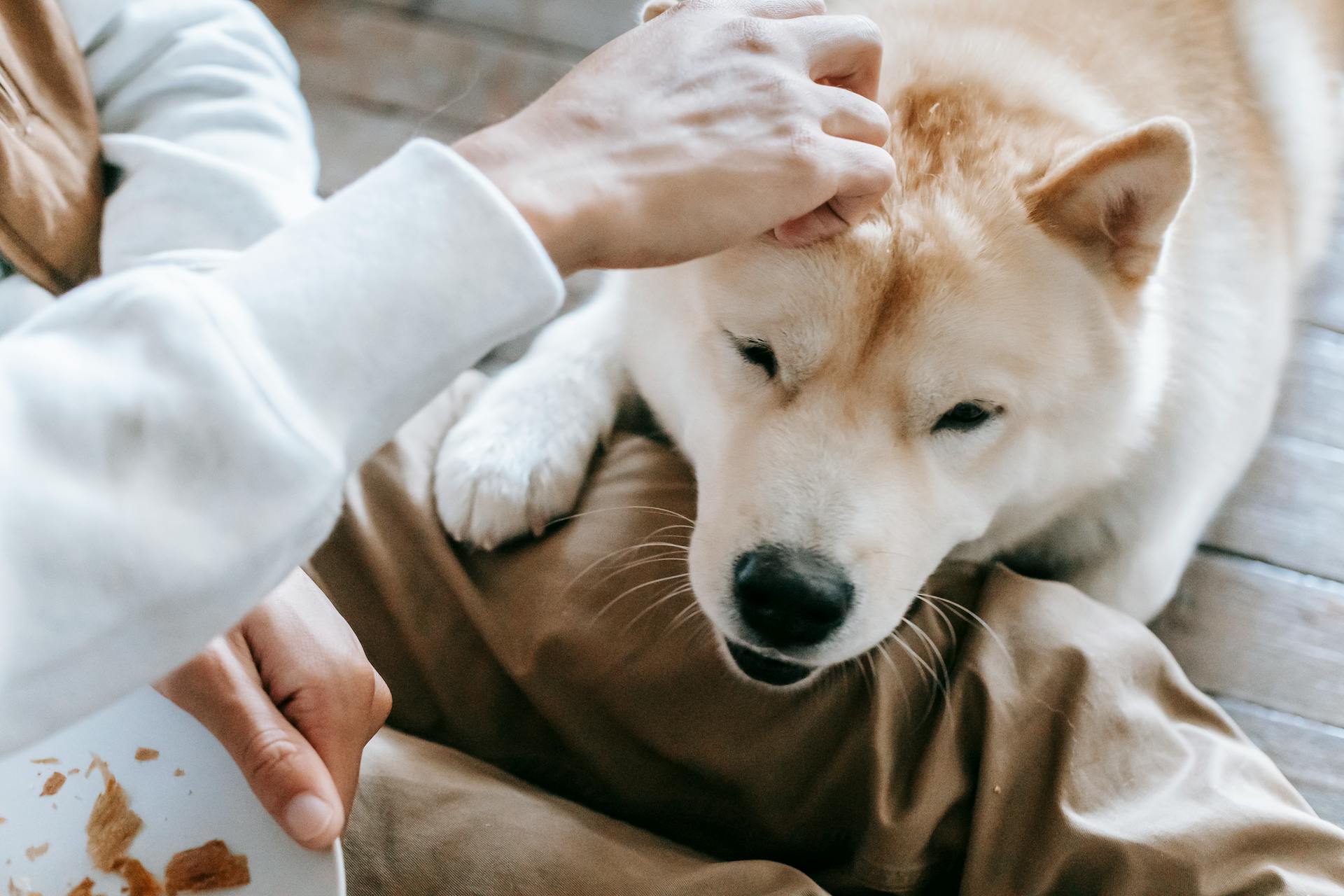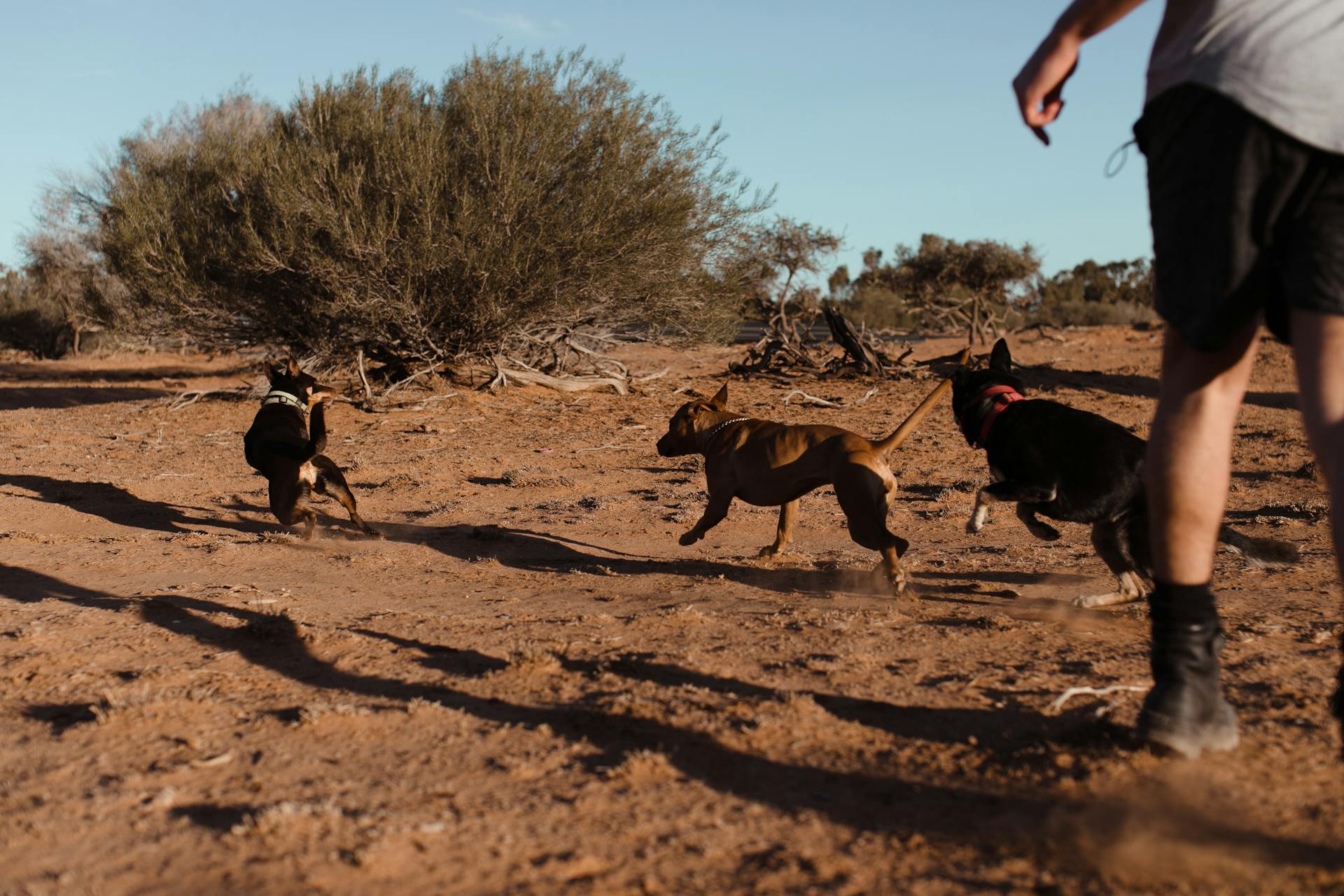
Panic attacks in dogs can be a terrifying experience for both the dog and its owner. A sudden, intense anxiety episode can occur in any dog, regardless of breed or age.
Dogs can exhibit panic attacks due to various reasons, including separation anxiety, noise phobias, or past traumatic experiences.
Panic attacks in dogs can manifest in different ways, such as panting, pacing, or destructive behavior.
Dogs may also display physical symptoms like rapid heartbeat, trembling, or drooling during a panic attack.
Additional reading: What to Do If Neighbor's Dog Attacks You?
Causes and Diagnosis
Panic attacks in dogs can be caused by a variety of factors, including separation anxiety, which affects around 14 percent of dogs. This type of anxiety manifests when dogs are left alone or separated from their family members, leading to undesirable behaviors like urinating and defecating in the house.
Separation anxiety can be triggered by being left alone, loss of a loved one or playmate, major life changes, or suffering a traumatic event. It's essential to note that dogs with separation anxiety often have a history of abandonment or rehoming, which can perpetuate the condition.
A veterinarian's first step in diagnosing panic attacks in dogs is to rule out underlying medical conditions, such as brain, thyroid, or adrenal disease, through blood tests and a physical exam. A complete physical examination and laboratory tests, including fecal smear, urinalysis, and complete blood count, should be done to ensure the dog's overall health.
Here are some common causes of anxiety in dogs, which can contribute to panic attacks:
- Genetics
- Abandonment
- Traumatic experiences
- Environmental changes
- Separation from the mother
- A new owner
- Changes in schedules
Causes
Dogs can develop anxiety due to a variety of factors. One of the most common causes is fear, which can be triggered by loud noises, strange people or animals, new environments, or specific situations like vet visits or car rides.
Separation anxiety affects around 14 percent of dogs, causing them to become distressed when left alone or separated from their family members. This can lead to undesirable behaviors like urinating, defecating in the house, destroying furniture, and barking.
Age-related anxiety affects older dogs and can be associated with cognitive dysfunction syndrome (CDS), which causes memory, learning, perception, and awareness to decline.
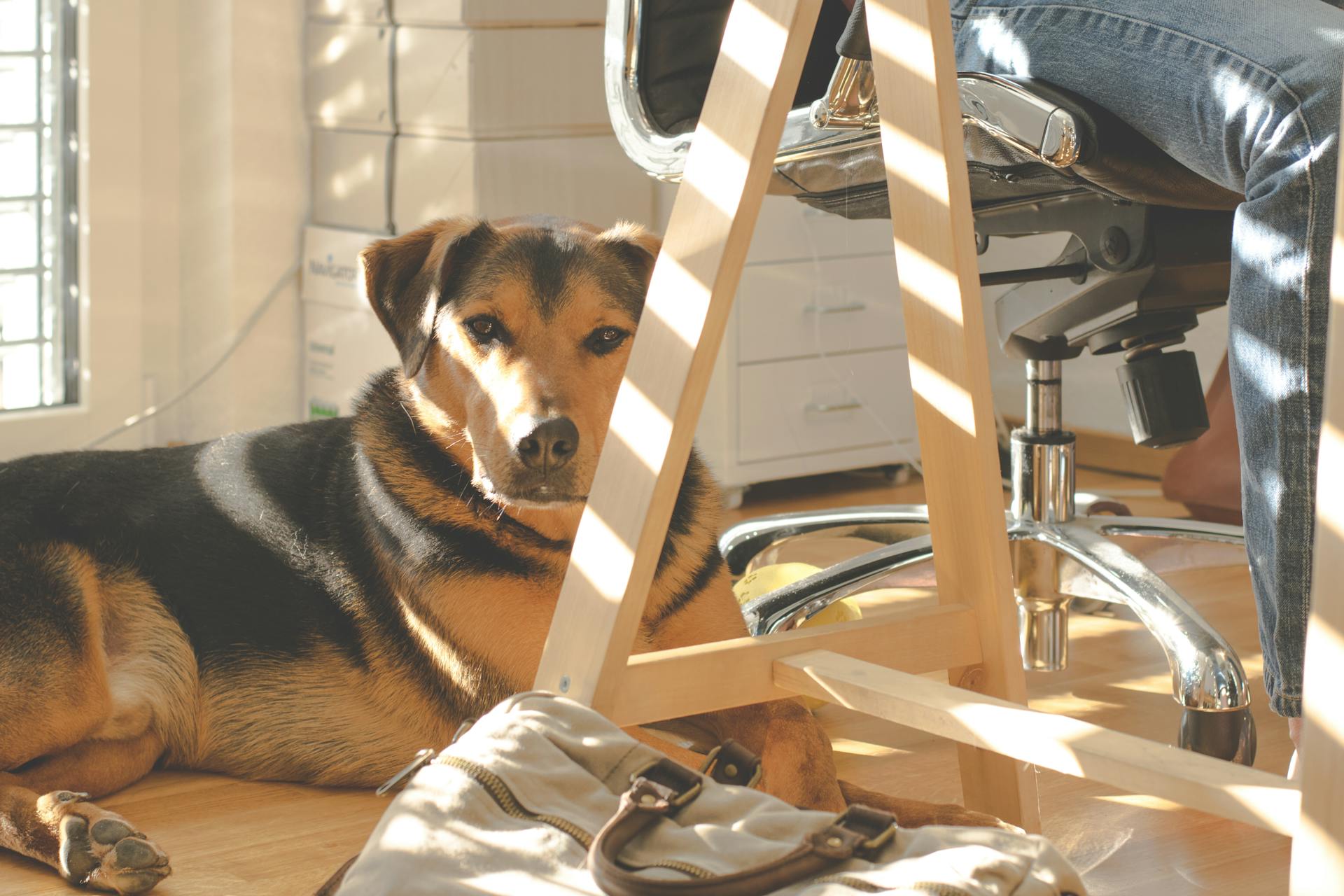
Here are some common causes of anxiety in dogs:
- Fear
- Separation
- Aging
- Being left alone
- Loss of a loved one or playmate
- Major life change
- Suffering a traumatic event
- Being forced into an unfamiliar and frightening experience
- Being deprived of social and environmental exposure until 14 weeks of age
- History of abandonment, having multiple owners over time, being rehomed, or experiencing prior neglect
- Genetics
- Abandonment
- Traumatic experiences
- Environmental changes
- Separation from the mother
- Changes in schedules
Some of these causes can be linked to specific events or experiences, while others may be more complex and difficult to pinpoint.
Diagnosing
If your dog has had multiple panic attacks, it's crucial to have him checked by a veterinarian. A complete physical examination is a must to rule out any underlying conditions that need treatment.
You should bring a video of your dog during a panicked state to the clinic, as it can provide valuable information to the veterinarian. Keeping a record of the circumstances of the attacks can also help pinpoint triggers.
Your veterinarian will likely want to rule out other conditions that might be causing the behavior, such as brain, thyroid, or adrenal disease. Blood tests will help confirm or rule out possible underlying medical conditions.
A complete physical examination, laboratory tests, and a thorough medical history are essential in diagnosing the root cause of your dog's panic attacks or fear and anxiety.
Symptoms and Signs
Panic attacks in dogs can be a frightening experience for both the dog and its owner. A panic attack can come out of the blue with no warning, or it may occur every time a certain thing triggers one.
Some common signs of a panic attack in dogs include rapid breathing, fast heart rate, drooling, dilated pupils, pacing, loss of appetite, ears back and tail tucked under, hiding, shaking or trembling, excessive licking or chewing on skin and fur, whining or howling, and barking more than usual.
Here are some specific signs to look out for:
- Rapid breathing
- Fast heart rate
- Drooling
- Dilated pupils
- Pacing
- Loss of appetite
- Ears back and tail tucked under
- Hiding
- Shaking or trembling
- Excessive licking or chewing on skin and fur
- Whining or howling
- Barking more than usual
- Extreme aggression such as growling or biting
- Overly attentive (climbing on you, licking you)
- Behavioral problems such as digging or scratching
- Trying to escape or run away (scratched up door or damaged fence if owner is not home)
- Urinating or defecating indoors
These signs can vary depending on the type of anxiety causing the panic attack, such as confinement anxiety, travel anxiety, noise anxiety, or separation anxiety.
Treatment and Management
Your veterinarian can help you identify the type of anxiety your dog suffers from and the possible causes and triggers.
If your dog continues to have panic attacks, the veterinarian may prescribe anxiety medication alongside behavioral therapy. Tranxene, fluoxetine, buspirone, amitriptyline, and alprazolam are some of the most common medications that have been successful in treating panic attacks.
Regular exercise can help reduce anxiety in dogs. Some experts encourage more vigorous exercise for pets with anxiety and panic attacks, which can tire your dog physically and mentally, reducing anxiety.
Providing a safe space for your dog can make them feel much safer when needed. A small room or cage that is just for your dog where they can go to get away can be a great idea.
In some cases, hospitalization may be the best choice for dogs with extreme panic and separation anxiety. This can be necessary until medications can become effective, which can take days to weeks.
You may need to arrange for day care or dog-sitting to provide protection from self-inflicted physical injury until your dog calms down.
Prevention and Training
Desensitization and counter-conditioning are effective strategies to prevent and treat dog anxiety. Desensitization involves repeated, controlled exposure to the stimulus that usually causes a fearful or anxious response, done at a low intensity that the dog does not respond with fear or anxiety.
Proper socialization can prevent the development of anxiety by introducing your dog to new people, dogs, animals, places, and experiences. This helps your dog become a well-adjusted canine citizen.
Situation avoidance can also help prevent anxiety by avoiding or preventing situations that trigger your dog's anxiety. For example, if your dog grows anxious around large groups of dogs, you should avoid dog parks.
Training is a crucial part of preventing and treating dog anxiety. Counter-conditioning can be used to train your dog to perform a positive behavior in place of fear or anxiety, such as teaching your dog to sit and stay.
Preventing and Treating
Preventing anxiety in dogs can be achieved through proper socialization. Introducing your dog to new people, dogs, animals, places, and experiences can help avoid an exaggerated response down the road.
Desensitization and counter-conditioning are effective strategies to treat anxiety in dogs. Desensitization involves repeated, controlled exposure to the stimulus that usually causes a fearful or anxious response, while counter-conditioning trains the dog to perform a positive behavior in place of fear or anxiety.

You can teach your dog to sit and stay, and reward them for performing these tasks. This can help redirect their attention when they're in a situation where they're usually fearful or anxious.
Recognizing your dog's physical signs of fear, phobias, and anxiety is crucial to intervene before they panic. These signs can be subtle and may include panting, whining, and licking.
If your dog has been diagnosed with anxiety issues, avoiding situations that trigger their anxiety can be helpful. For example, if your dog grows anxious around large groups of dogs, you should avoid dog parks.
Providing a safe space for your dog to retreat to can be beneficial. This can be a furniture-style enclosed crate, a covered "cave" bed, or a doggie tent bed.
Medications can be prescribed by your veterinarian to help treat anxiety in dogs. However, these should be used as a last resort, and behavioral therapy should be implemented alongside medication.
Exercise can help reduce anxiety in dogs, and some experts recommend more vigorous exercise to tire them physically and mentally.
For another approach, see: Dog Boarding for Anxious Dogs
Treat Stuffer Toys
Treat stuffer toys are a great way to calm your dog's anxiety. They work by providing a long-lasting source of yummy treats that your dog can lick out, forcing them to focus on the task at hand.
Kong toys are a classic example of treat stuffer toys that have been trusted by dog owners for years. They're a simple yet effective way to keep your dog occupied and calm.
The Stashios Soothing Saucer is a newer innovation that offers a similar solution. It's designed to appeal to your dog's natural instinct to lick and soothe themselves, making it a great tool for anxiety relief.
Worth a look: What to Do with Your Dog's Ashes?
Medications and Supplements
Anxiety medications for dogs may be prescribed by your veterinarian to help manage panic attacks. Your veterinarian may recommend medications such as SSRIs and antidepressants, like fluoxetine and clomipramine, for dogs with anxiety.
For predictable anxiety-producing events, your veterinarian might prescribe a medication like benzodiazepine in conjunction with an antidepressant. This can help your dog cope with the stress of events like thunderstorms or car rides.
Selegiline is also used for treating chronic anxiety in Europe and can be beneficial for senior dogs with cognitive dysfunction syndrome.
Medications

Medications can be a viable option for dogs with anxiety disorders. Your veterinarian may recommend medications or natural therapies to help your dog cope with anxiety.
SSRIs and antidepressants like fluoxetine and clomipramine are occasionally prescribed for dogs with anxiety. These medications can help reduce symptoms of anxiety in dogs.
For predictable anxiety-producing events like thunderstorms or fireworks, a medication like benzodiazepine may be prescribed in conjunction with an antidepressant. This can help your dog feel more calm and relaxed during stressful situations.
Selegiline is a medication that can help reduce symptoms of cognitive dysfunction syndrome in senior dogs. It's also used to treat chronic anxiety in Europe.
Natural therapies and products can also be used to help dogs with anxiety, and some work best in conjunction with other medications.
CBD Benefits
CBD oil has been reported by some dog owners to be effective in treating dog anxiety. CBD is a compound found in cannabis and hemp that has been found useful for treating various health conditions.
While there is no scientific data on how CBD oil affects dogs, many owners claim it can help calm their pets when stressed. It's essential to consult with a veterinarian before using CBD oil as a treatment for dog anxiety.
Some CBD products are not regulated, which means consistency and purity may not be validated. Your veterinarian can help determine if CBD oil is a good treatment for your dog's anxiety and discuss different products, possible side effects, and risks.
CBD has also been shown to have anxiolytic properties, which can help manage various dog disorders. It's recommended to consult a qualified vet when your dog has a health problem.
CBD oil can be infused with organic ingredients and comes in flavors pets love.
For your interest: Why Do Dogs Stop Eating Their Food
Recovery and Overcoming
Recovery from panic attacks in dogs requires time and patience, but it's possible with the right approach. Working with your dog to ease anxiety can be a game-changer.
Your veterinarian can help determine the severity and root cause of your dog's anxiety, fear, or phobia. This is a crucial step in developing an effective recovery plan.
Panic attacks can be managed, and with the help of a pet therapist, you can work together to overcome them.
Recovery

Recovery is possible with time and patience. Working with your dog can help ease anxiety and manage panic attacks.
It may take some time to see progress, but with consistent effort, you can help your dog feel more at ease. Pet therapists can provide additional support if needed.
Panic attacks in dogs can be managed with the right approach. By working together with your dog, you can create a more relaxed and calm environment.
Recovery is a journey, and it's essential to be patient and understanding of your dog's needs. With time and effort, you can help your dog overcome anxiety and panic attacks.
Overcoming Phobias
If you suspect your dog has a phobia, it's essential to address it promptly to prevent it from escalating into generalized anxiety.
The most common phobias in dogs are associated with noises, such as thunderstorms or fireworks. These can be overwhelming and even life-altering for your furry friend.
To overcome a phobia, your veterinarian will work with you to determine the severity and root cause of the behaviors. This collaborative approach will help you develop a plan to address the phobia effectively.
Common phobias in dogs include loud noises, insects, humans, and even medical procedures like blood draws or injections.
If your dog is exposed to the trigger without intervention, they may become constantly anxious and anticipate a negative experience. This can lead to a range of behaviors, from fear-based reactions to generalized anxiety.
Some common phobias in dogs include:
- Loud noises like thunderstorms or fireworks
- Insects, especially if they've received painful bites or stings
- Humans, often men or certain apparel associated with a traumatic situation
- Blood draws or injections at the veterinarian
Desensitization and counter-conditioning are effective techniques to help your dog overcome a phobia. By gradually exposing them to the trigger in a controlled environment, you can help them become less reactive and more confident.
Body Language and Behavior
Learning to read dog body language is crucial in understanding panic attacks in dogs. Knowing when your dog is uncomfortable or scared can help you avoid negative experiences.
You can tell when a dog is getting anxious by reading their body language. This is especially useful if your dog has a history of aggression-related anxiety.
Some common signs of anxiety in dogs include a tucked tail, panting, and yawning.
Check this out: When You Lie down with Dogs?
Body Language
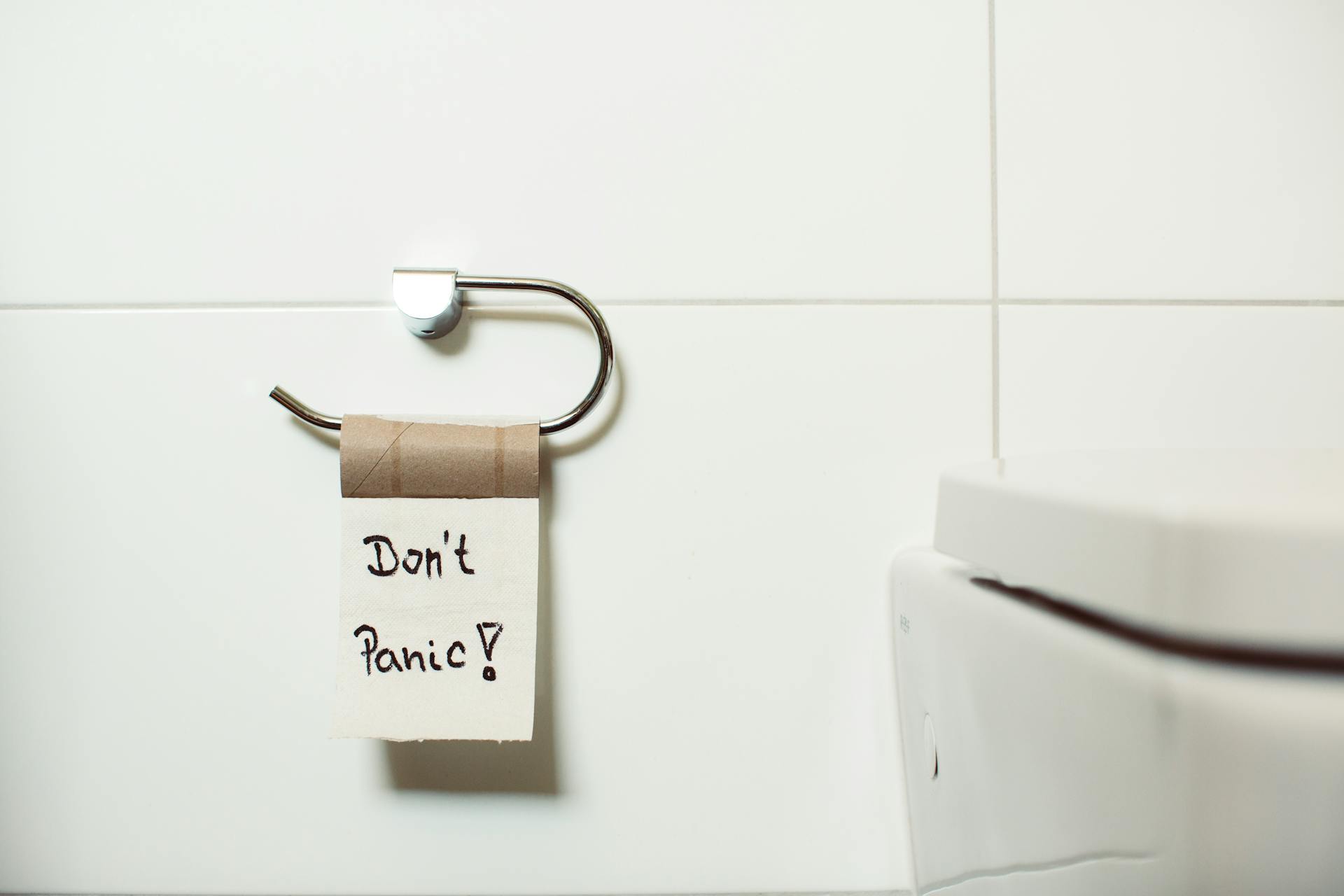
Learning to read dog body language is a crucial skill for any dog owner. It can help you avoid negative experiences and use them as a positive training moment.
Knowing when your dog is uncomfortable or scared can be a game-changer. By recognizing the signs, you can intervene and prevent a potentially stressful situation.
Dogs often show their anxiety through body language, which can be a warning sign if left unaddressed. If your dog has a history of aggression-related anxiety, this skill is especially important.
A dog's body language can tell you a lot about their emotional state. By paying attention to their posture, facial expressions, and other nonverbal cues, you can get a better sense of what they're feeling.
When Always Seems on Edge
If your dog is always on edge and can't seem to shake off the feeling, it might be a sign of anxiety.
Dogs with anxiety are often always walking around nervous, like they're waiting for something to go wrong.
Generalized anxiety can develop from regular exposure to something your dog has a phobia of, but it can also be caused by something as simple as the upsetting of routines or environment.
Veterinarians estimate that 50% of dogs and cats suffer from some form of fear, anxiety, or phobia.
A dog with general anxiety is almost always on the lookout, and always seems on edge and unable to let their guard down, which can be a recurring or even continuous state.
Anxiety in pets has significantly increased since the pandemic, according to a recent study.
It's essential to review your dog's symptoms with a veterinary professional before choosing a method of treatment, and online telehealth options like The Kinship can make it easy and affordable to consult with a licensed veterinarian anytime, day or night.
When to Seek Help
If your dog's anxiety is not responding to at-home remedies, it's time to seek help. Consult with a veterinarian or a telehealth tool like The Kinship to discuss your anxious dog.
A dog's anxiety can be a serious medical issue that requires consultation with your veterinarian to identify a comprehensive treatment plan. Left untreated, your dog's behavior may deteriorate quickly and become problematic.
Your veterinarian can help determine if there is an underlying health issue contributing to your dog's anxiety. They can also provide options such as behavior modification or medication to alleviate stress in your pet.
Don't hesitate to seek help if your dog's anxiety is related to other health issues. Your veterinarian can help you identify the underlying causes and develop a treatment plan to address them.
Suggestion: Why Is My Dog's Pee Greasy?
Frequently Asked Questions
How long does a dog panic attack last?
A dog's panic attack typically lasts only a few minutes, but can feel like an eternity for them. Understanding the duration and causes of panic attacks can help you better support your furry friend.
Sources
- https://www.akc.org/expert-advice/health/treating-dog-anxiety/
- https://wagwalking.com/condition/panic-attacks
- https://www.petmd.com/dog/conditions/behavioral/c_dg_fears_phobia_anxiety
- https://www.pethub.com/articles/242692/recognizing-abnormal-canine-stress-and-dog-anxiety
- https://focl.com/blogs/learn/can-dogs-have-anxiety-attacks
Featured Images: pexels.com
